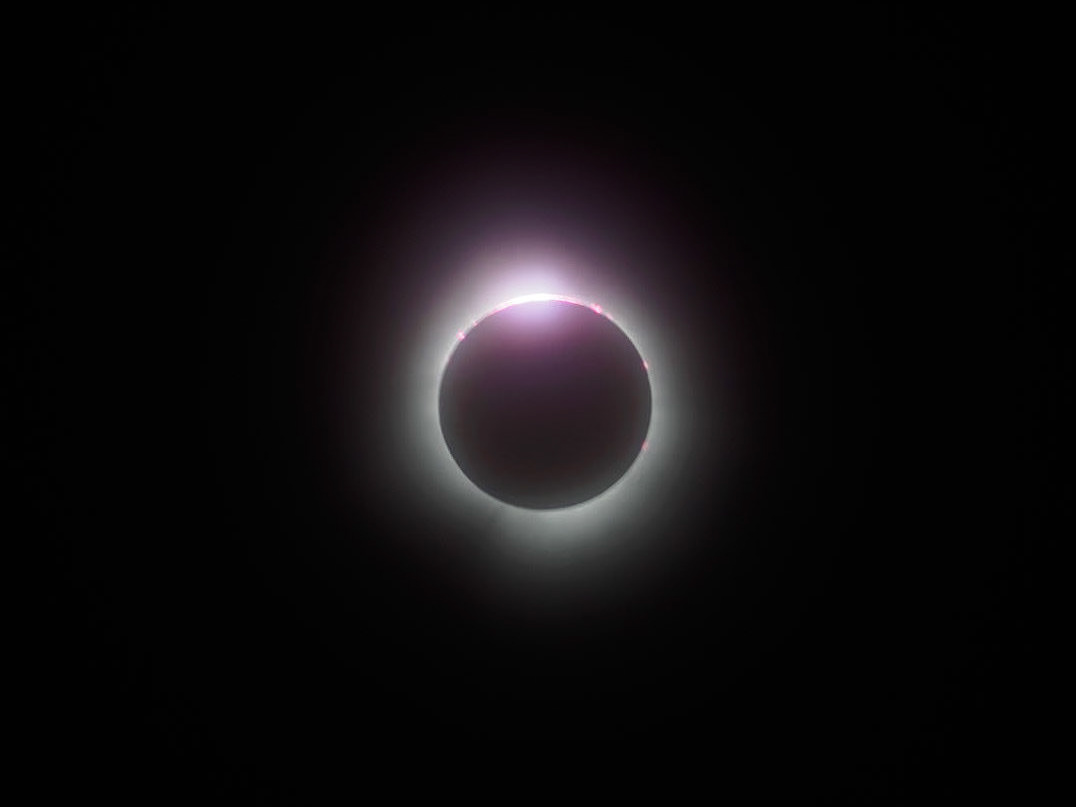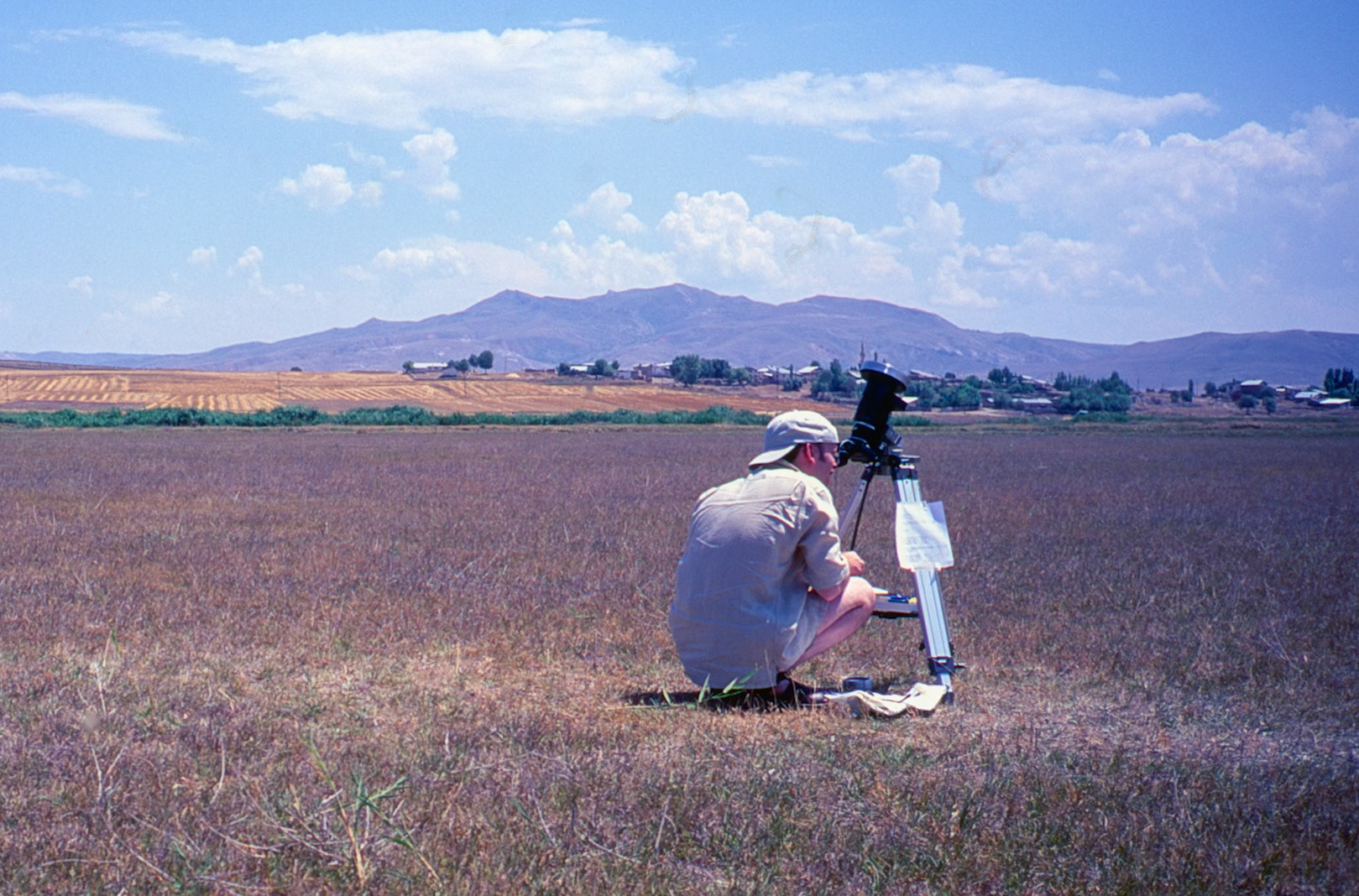
Eclipse observing site Sivas, Turkey
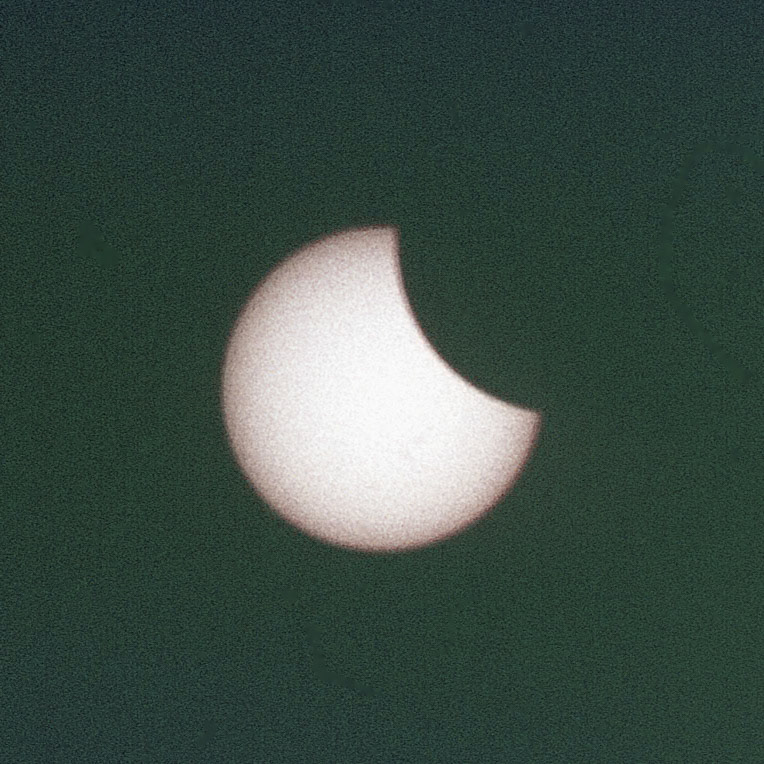
Partial phase

Venus and the Sun

Totality
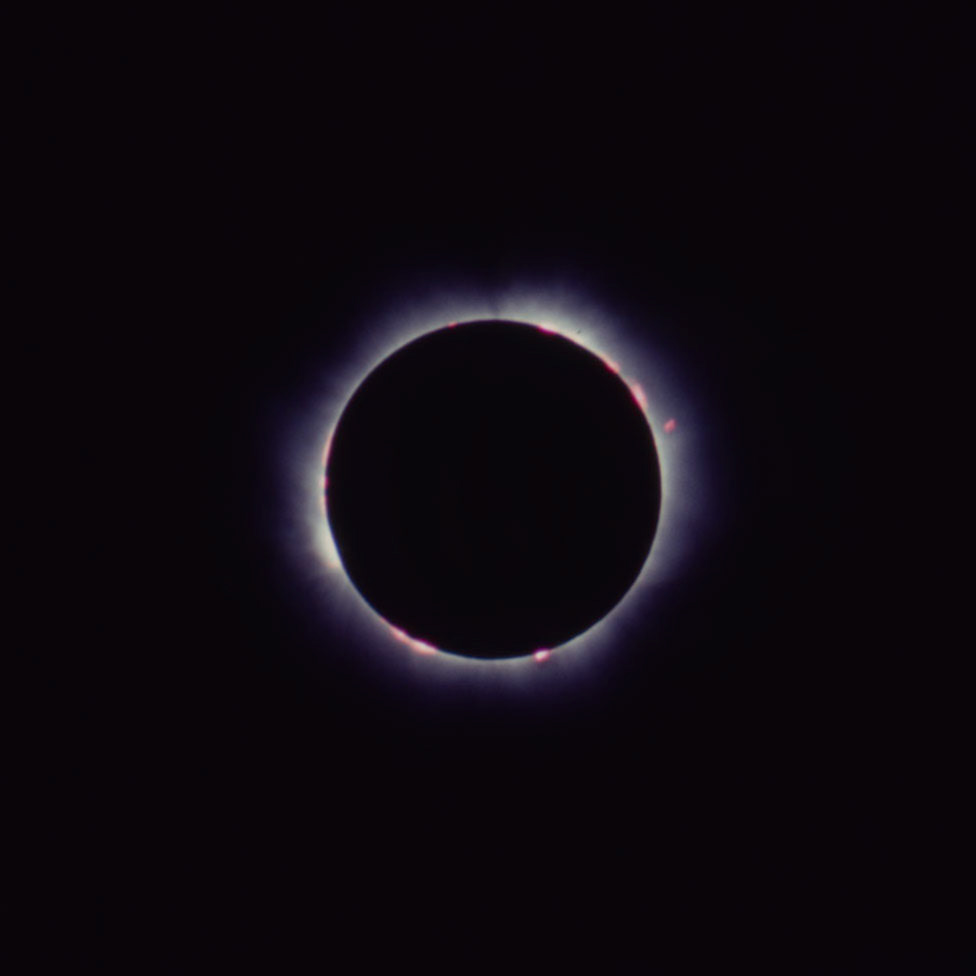
Totality

Totality

Totality
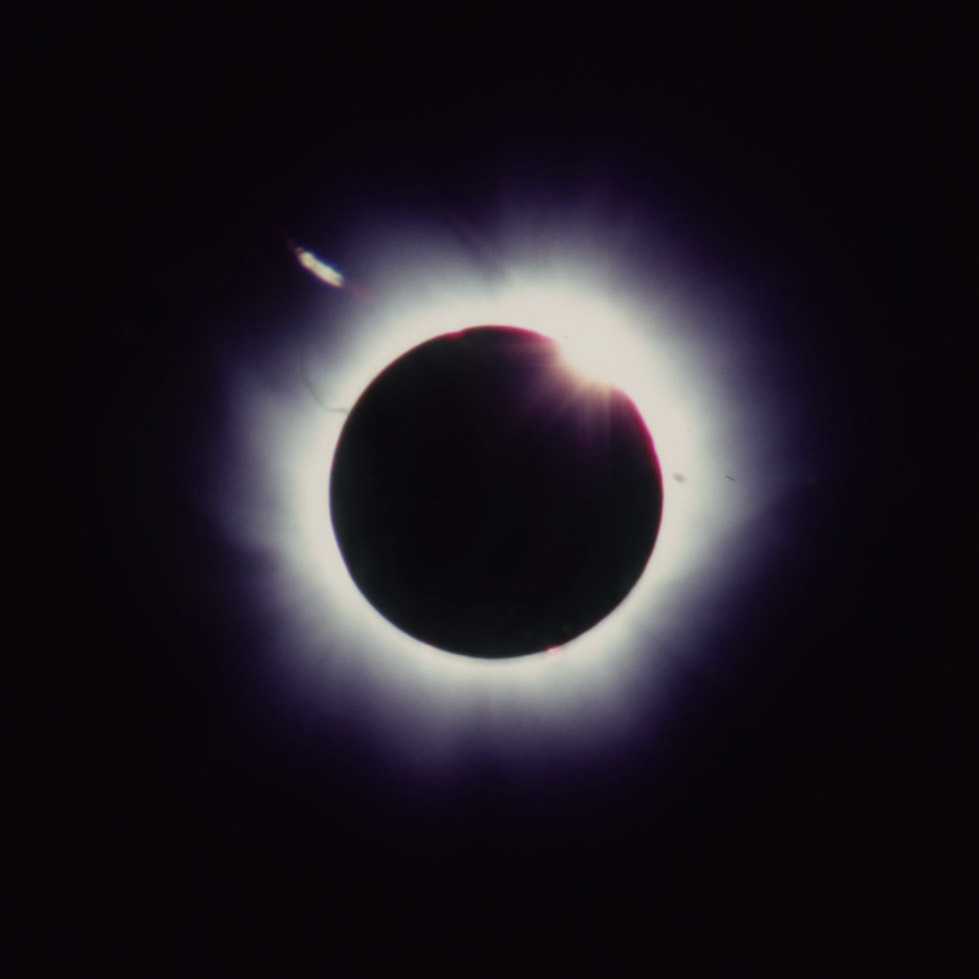
Diamond ring

Diamond ring
The following commentary was written contemporaneously by my fellow eclipse adventurer Andrew Greenwood ...
After spending two very busy days in Istanbul at the start of our expedition, we caught our internal flight to Kayseri. The duration of the flight was approximately two hours. Our captain cast shadows of doubt in our minds by informing us that our destination was overcast with cloud - the dreaded 'C'-word! As our flight progressed, his forecast seemed accurate enough - towards the east (our general direction of travel) lay a blanket of cloud.
At an altitude of approximately 11,000 feet, on the southern horizon stood a single Cumulonimbus cloud like a sentinel. This cloud fascinated me, I watched as high altitude winds teased its top into a distorted shape resembling an anvil. Little did I know that this was the forebearer to some very anxious moments ... As I watched the Sun set in the west, I wondered if it would be the last time I saw it. Upon landing at Kayseri, (a military airbase) we were escorted by armed guard to the civilian terminal building. To my relief, when I looked toward the sky, it was clear!
Our next excursion would take us by road, on a three and a half hour journey to Avanos - our base for the next two days. Even though by now, darkness had fallen and I was tired, I didn't want to sleep. Instead, I pressed my face up against the coach window to catch a glimpse of the stars. What a lot there were! Long stretches of unlit highway through the countryside provided a sky that was dark and transparent. There before me lay Ursa Major, Cassiopeia and Perseus - I was sure I could see the Milky Way! Also on view were bright Arcturus and over to the southwest Mars was hanging low.
On arrival at our hotel, we were greeted by a rather disconcerting message ... Thunder storms were forecast for eclipse-day in Sivas - the area in which our observation site was located. To make matters worse, we needed to be awake the following morning at half past four! This would allow us to travel further afield, if conditions were less than promising.
Our hotel room was hot. The air conditioning, even turned up full, just didn't help. So after preparing our equipment for the following day, we tried to get our three and a half hours sleep ... Four thirty soon came around. First things first - take a look outside - thank goodness, the sky was perfectly clear. Towards the zenith, shining extremely brightly, was Jupiter - a lovely sight.
After breakfast we boarded our coach for the six hour journey to Sivas. Bleary-eyed, as we drove away from our hotel, the Sun rose above a nearby mountain and sent orangey-red light spilling on to our faces. A cheer went up - we were on our way! It was six o'clock.
Once again, even though I was very tired, I just didn't want to sleep, so much lay ahead. It was at this point that I made my decision to image the eclipse on 100 ASA film. I set about writing an exposure table for the partial phases and totality. This way I knew exactly what I needed to do and when.
As the morning progressed, there was no sign of any cloud whatsoever. After our third and final stop to stretch our legs, we began the last portion of our journey. Only 120 kilometres to go. The landscape around us was dry, parched and extremely barren. Huge plains bordered by mountain ranges, inter-spaced with oases of green - crops of watermelon and grapes.
As the temperature rose to a dizzy mid-thirty degrees, so did the cloud. Over on the eastern horizon, towering columns of water vapour were condensing. Though by no means excessive, I refused to believe we were going to see an eclipse at all. We climbed into the mountains, where we saw some breathtaking scenery. The geology of the area was striking - I could see volcanic and sedimentary layering in the rocks all around us - clearly, these mountains were old!
Descending into Sivas an expectant atmosphere grew as we approached our destination. After a short time, we turned off the main highway and travelled down a narrow tarmac road for approximately half a mile. We had arrived!
Soon off the coach, we were able to survey our site. It was perfect. A vast, open-space with the low lying mountains of Tecer Daglari in the distance. We collected our belongings and walked across the fields for quarter of a mile or so to our own observation plot, well clear of anyone else. The stubble-like dried grass around us was full of crickets. I noticed that when I placed my feet on the ground as I walked, they scattered in all directions. It was quarter past twelve, just over fifty minutes before First Contact.
Once I had set up my photographic equipment and shot two 'keyframes' of the landscape around me, I decided to take a look at the Sun. As I manoeuvred my equipment in the general direction, I made its shadow as condensed as possible. Looking through my f8, 500mm mirror lens with 2x converter and Thousand Oaks type 2+ solar filter, the Sun was nowhere to be seen. How I struggled to find my target - it seemed so easy at home!
Fifty four minutes past twelve, t-minus fifteen minutes. It became apparent that the cloud we could see wasn't going to affect us as it was moving in an easterly direction. Initially worrying, but extremely spectacular nevertheless, a large anvil-shaped Cumulonimbus cloud, chased by two smaller ones hung in the sky to the east. Whilst counting down the minutes and seconds until First Contact, I remember thinking to myself that I couldn't believe I was just about to see my first total solar eclipse!
Six minutes past one o'clock, First Contact was upon us. But it wasn't ... it was a full thirty seconds before I saw a minute portion of the lunar disk starting to creep over the Sun. 'First Contact!' I shouted. Click, click, click - the first three exposures of the partial phases - 1/125th, 1/60th and 1/30th of a second. I felt so excited, this was it - it was really happening! At five minute intervals, I continued to record the progress of the celestial show before me. After the initial excitement of First Contact, the passage of the Moon across the solar disk seemed to grind to a halt. Around fifty percent coverage was indicated by the first of a trio of sunspots to be obscured. Interestingly, each spot was 'eaten-up' in almost precisely five minute intervals. I wondered if it would be possible to calculate the distance between each, given the time taken to travel between the first and last.
At half an hour before totality, it was time to load a new roll of Kodak Elite Chrome transparency film. Before leaving for Turkey, I had calculated that I could either leave myself eight, or two minutes before Second Contact to change rolls. This was on the assumption that I would bracket two exposures for the partial phases. In reality, I bracketed at three shutter speeds for each exposure. I'm so glad I did. The whole process was probably one of the most stressful exercises I have ever undertaken! I had taken care to place the lenses, filter, cable release, etc., in set positions so I could easily re-assemble my equipment. Mysteriously, everything had become hidden from view ... where had I put everything?! What should have taken a couple of minutes took considerably longer.
As the solar crescent waned, I thought of projecting the partial phase onto the ground by crossing my fingers over one another to create a crude pinhole camera. It worked!
All of a sudden, about fifteen to twenty minutes before totality, Andrew, my partner for the expedition, pointed out that the quality of the light had changed. Indeed it had, the colour in the landscape had become quite watery. I checked my shadow. The hard edges around the outline of my figure were diffuse and the inner shadow had become darker. Also, the air temperature had started to drop. It was to plummet approximately ten degrees during mid-eclipse.
I was ready for totality. As I focussed on the last slender phases of the Sun, at less than five minutes before Second Contact, everything around us looked positively weird. The land had become almost semi-transparent, as if crystalized. I felt that if I had plucked a blade of dried grass, it would have splintered in my fingers. I noticed that the street lamps in the nearby village of Guydun had turned themselves on. Then, somewhere in the distance, a cock started to crow as if it were daybreak. I looked around for the three dragonflies that had been buzzing about us since First Contact - they had disappeared. We were surrounded by silence. It had been quiet before, but now even more so - the stillness seemed to have arrived in stages. I watched for shadow bands, but saw none.
I returned to my camera viewfinder for my last set of exposures, click, click, click. I couldn't believe how slender the Suns crescent was! Andrew called ' ... about five minutes!' 'No way, it's coming, it's coming!' I replied. I was shaking. I tried to remove the solar filter from my lens, but in the process, lost critical focus by accidentally twisting the focussing ring. Oh no, not now! Back on with the filter, re-focus, then carefully remove it again ...
This really was it, the moment I had waited for, over the last thirteen months!
The light began to fade faster than ever, as if turning down an enormous dimmer switch. I squinted my eyes and moved them back to the camera, Baily's beads and the diamond ring were yet to come, but I could already see the corona! The next I remember is hearing a collective cheer from our left hand side. I shouted, 'Diamond ring!' It looked just as I had imagined it - a huge solitaire suspended in the sky, with a band of corona coming into view around it. Had there not been any Baily's beads ...?
I was in awe. 'I can't believe it, I can't believe it!', I couldn't help but repeat myself over and over. Venus was next - an easy target to the left of the eclipsed Sun. I searched for Mercury, but couldn't see it. I would try again later. Nothing prepared me for what I saw through my viewfinder. Prominences - lots of them! I quickly counted six or eight, iridescent and ruby red in colour. Amazingly, one was detached, floating free of the solar limb. Wow! Next was the corona, a pearly blue veil, full of incredible detail - more than I can recall. It seemed to extend all the way to the edges of my field of view. Andrew said that the corona extended well beyond the edges of his viewfinder, and he was using a 500mm lens - half the focal length of mine.
By this time, I had begun my exposures for totality. One twenty-fifth of a second all the way down to four seconds. Ten exposures in total. I couldn't believe the incredible intensity and depth of blackness in the silhouetted lunar disk. I had never seen a shade of black quite the same. It was almost as if there was a huge void where the Sun once was ... My practice had paid-off, I had completed all the photography I required, with a full minute of the total eclipse still to spare. I would be back for more images as Third Contact approached.
I was now able to take in the whole spectacle 'naturally' by naked-eye. The sky had turned a deep purple-blue. In a perfect circle all around us, the horizon was a fiery-orange. Probably stretching to ten degrees in altitude. From here to the zenith above us, we were in the lunar shadow. I felt like I could really see the extent of the diameter of the Moon. Those Cumulonimbus clouds! They looked so angry - steely-grey around the edges and lit within by an eerie orange light. They certainly added an extra dimension to the whole scene.
Back to totality. The corona was a delicate and pearly-blue in colour. I expected it to be near-circular and therefore uniform in shape, given that the Sun was approaching solar maximum. Yet I described it as being 'spiky', especially (as I recall) towards the lower left. The coronal streamers were magnificent! The whole scene looked so different than I had imagined. The pictures I had seen in books had seriously affected my perception of the true 'visual' nature of the event. Strangely, I almost felt like it's impact was anti-climatic. 'Mercury!' was next. I could see it now that my eyes had become adapted to the half-light. It was much fainter than I expected, situated to the lower right of the eclipsed Sun. I was to be one of only a few people who saw it.
The end of the celestial show was fast approaching - the trailing limb of the Moon was starting to brighten. It was time to try and capture the diamond ring and Baily's beads again. Unfortunately, due to the extremes in exposure time between the two, I wasn't quite as efficient as before and fumbled my exposures. Having said this, unbeknown to me at the time, I was lucky enough to have secured an image of Baily's beads. I don't recall much of the second diamond ring, except that it was brighter than the first and just as spectacular!
Once again, the light began to rise, but before my first total solar eclipse was over, I witnessed something quite strange. Whilst at my camera during the diamond ring, out of the corner of my eye, I saw three flashes of light. Two white and one red. I have no explanation as to what this could have been. Initially, I wondered if it could have been the Sun's rays bursting through and over the lunar valleys and mountains, creating sharp increases in the intensity of the light. Others said that it may have been shadow bands, a flashgun firing or even Perseid meteors/fireballs.
Totality was now over, but what a long two minutes seven seconds it had seemed to be! My mind was so full of what had happened before my eyes, that the next twenty minutes seemed like twenty seconds. It had taken the Moon an age to move towards Second Contact, but now it was rushing away at an incredible pace towards Fourth. Sadly, it was time to pack my equipment away. Unfortunately, I was unable to stay for Fourth Contact. As I started to walk towards the coach, a Land Rover containing four armed guards pulled up beside me. Oh no, what had I done?! They gestured for me to climb aboard - they were offering to give me a lift back - excellent!
On the return journey to Avanos, I couldn't contain my excitement as I watched video recordings and chatted about what we had just seen. As we approached our hotel, once again the Sun set behind the mountains. We hoped to see the green flash, but it didn't materialize.
I remember sometime ago, having read or been told that everyone should make a point of watching the Sun rise and set at least once during their lifetime ... I had seen both and witnessed the final total solar eclipse of the Millennium. What a truly inspirational experience! I can't wait for 2001 ...
Andrew Greenwood



